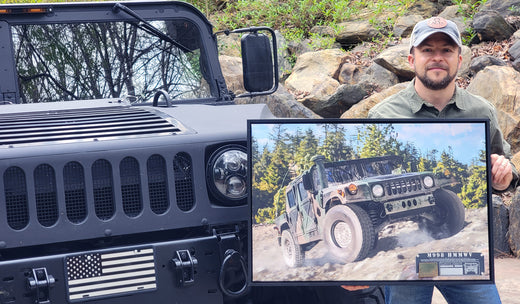This Fine Art Print by Artist Craig Tinder depicts the revered High Mobility Multipurpose Wheeled Vehicle (HMMWV) or better known as the 'Humvee'. A highly versatile combat service vehicle, the M998 configuration replaced the aging M151 series Jeeps in 1989. This Limited Edition Canvas Print includes an actual relic from a veteran HMMWV.
Details About the RELIC:
This fragment is an authentic piece of supplemental door armor from a U.S. Military High Mobility Multipurpose Wheeled Vehicle (HMMWV), commonly known as the Humvee. The vehicle, a staple of U.S. ground forces since the 1980s, was designed to serve in a variety of roles, from troop transport to light combat support. To enhance protection for soldiers operating in increasingly hostile environments, especially during conflicts in Iraq and Afghanistan, supplemental armor kits were developed and fitted onto the Humvee's doors and body. This particular armor fragment consists of multiple steel plates riveted together on the exterior of the vehicle's door, offering added defense against small arms fire, shrapnel, and improvised explosive devices (IEDs).
 Up-close view of the M998 relic mounted on canvas art piece
Up-close view of the M998 relic mounted on canvas art piece
The steel armor plates were layered and designed to be modular, meaning they could be added or replaced in the field as needed. The exterior of the armor was painted with the standard tri-tone camouflage pattern used by the U.S. military, which helped the vehicles blend into diverse environments, from desert to woodland terrain. The paint used on these vehicles is CARC (Chemical Agent Resistant Coating), a specialized coating that not only provides camouflage but also resists corrosion and protects the vehicle's occupants from chemical, biological, and radioactive threats. CARC's durability and resistance to chemical agents have made it a standard for military vehicles exposed to hazardous combat zones.
 Artist, Craig Tinder, holding the "M998 HMMWV" relic art print next to his personal M1123 Humvee
Artist, Craig Tinder, holding the "M998 HMMWV" relic art print next to his personal M1123 Humvee
The Story Behind the Print:
Introduced in 1989, the High-Mobility Multipurpose Wheeled Vehicle (HMMWV), commonly known as the Humvee, replaced the aging M151 series Jeeps, marking a significant upgrade in the U.S. military’s ground vehicle fleet. Engineered for extreme versatility, the M998 Humvee is capable of transporting a 2,500-lb payload and tackling the toughest terrains with ease. Its rugged design includes the ability to climb slopes of up to 60% and ford water up to 60 inches deep, making it ideal for a wide range of military missions. The vehicle’s 16 inches of ground clearance allows it to navigate through difficult off-road conditions that would leave many other vehicles stranded.
 "M998 HMMWV" proudly displayed at Kascar/Hummer headquarters
"M998 HMMWV" proudly displayed at Kascar/Hummer headquarters
The Humvee became the global standard for off-road military vehicles, earning its reputation through its unmatched performance in various environments. Its modular design enables the Humvee to be configured for a multitude of tasks, from troop transport and cargo carrying to specialized missions such as ambulance duties, TOW missile launching, and serving as a machine gun platform. The Humvee has also been deployed in scout-reconnaissance roles and many other critical operations. Its adaptability has ensured that the vehicle can be equipped with different armor configurations, weapon systems, and communication devices depending on mission requirements.
Over the years, the Humvee has become an icon of military mobility, supporting operations in diverse theaters of conflict, including the Gulf War, Iraq, and Afghanistan. Its combination of durability, off-road capability, and mission flexibility has made it indispensable for modern military operations, solidifying its place as a cornerstone of military logistics and tactical support.
Learn more about The Debate and the Solutions of the Controversy Over Up-armoring? Click Here
To purchase or see similar items, visit here.
Commissioned by Museums, Treasured by Collectors





Share:
The Sparks of Titanium - Conservation in Relic Artwork
Old Glory - American Lager Now Available!